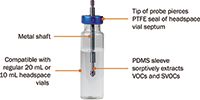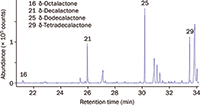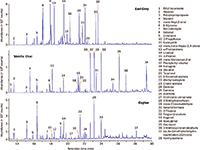Flavor Profiling of Milk and Premium Teas by HiSorb Sorptive Extraction with Thermal DesorptionGCMS Analysis
Special Issues
This study shows that the organic compounds giving rise to the flavor of beverages can be identified by high-capacity sorptive extraction using PDMS probes, wih analysis by thermal desorption–GC–MS.
This study shows that the organic compounds giving rise to the flavor of beverages can be identified by high-capacity sorptive extraction using PDMS probes, with analysis by thermal desorption–GC–MS.
Analysis of volatile and semi-volatile organic compounds (VOCs and SVOCs) in foods and beverages is important for quality control and product development/characterisation, and widely studied using GC–MS, but hindered by the limitations of existing sample preparation techniques.
Markes International's PDMS HiSorb(tm) probes allow immersive sorptive extraction from liquids (or headspace sorptive extraction from solids or liquids), without the expense of time associated with solvent-extraction methods, and with lower detection limits than SPME.

In this pair of studies, a HiSorb probe (Figure 1) was immersed into a 20 mL headspace vial, containing either (a) a mixture of semi-skimmed milk and analytical-grade water (1:1) or (b) freshly-brewed tea. The vial and probe were agitated on a HiSorb Agitator at 40 °C for 1 h, and the probe was then washed, dried, and inserted into an industry-standard 3.5-inch TD tube for desorption. Analysis used a TD100-xr(tm) thermal desorber (Markes International), a DB-5 column (for milk) or DB-624 column (for tea), and a quadrupole mass spectrometer used in scan mode.

Analysis of Milk
Figure 2 shows the complex profile obtained and the analyte range achievable with this analytical system-compounds ranged in volatility from C3 to C19 and included alkanes, aldehydes, alcohols, acids, esters, ketones, and lactones. The latter are particularly important flavor compounds, and in this example four ?-lactones were identified. To assess their relative concentrations, Figure 3 shows an extracted-ion chromatogram (EIC) at m/z 99, which is a principal fragment ion for these compounds. ?-Dodecalactone (#25) predominates within this group, and therefore could be judged to be a contributor to the flavor of this milk.

Analysis of Earl Grey, Vanilla Chai, and Ceylon Teas
All three teas show complex profiles with a large number of components at high and low levels (Figure 4). Characteristic components of the citrus fruit bergamot in the Earl Grey tea are limonene (#9), linalool (#14), and linalyl acetate (#23), while the vanilla-derived compounds eucalyptol (#11), anethole (#26), and coumarin (#35) are recovered from Vanilla Chai. The Ceylon tea shows some similar compounds to the other samples, such as linalool (#14) and eugenol (#33), but also some unique compounds, including 2-propylfuran (#10), phenylethyl alcohol (#17), and trans-cinnamaldehyde (#29).

Conclusions
HiSorb probes are an easy-to-use, highly sensitive approach to the sorptive extraction of VOCs and SVOCs from a range of sample types, including water-based solutions, emulsions, and suspensions, as well as solids. Unattended sample preparation, with automated analysis by thermal desorption (TD), ensures maximum sensitivity and productivity, while re-usable probes and tubes minimize the cost per sample.

Markes International
Gwaun Elai Medi-Science Campus, Llantrisant, Wales, UK
tel. +44 (0)1443 230935
Website: www.markes.com















The Benefits of Custom Bonded Silica
April 1st 2025Not all chromatography resins are created equal. Off-the-shelf chromatography resins might not always meet the rigorous purification requirements of biopharmaceutical manufacturing. Custom bonded silica from Grace can address a wide range of separation challenges, leading to real performance improvements. Discover more about the latest innovations in chromatography silica from Grace, including VYDAC® and DAVISIL®.
5 Things to Consider When Selecting a Chromatography Silica
April 1st 2025Particularly in the pharmaceutical industry, drug purity isn’t just a goal – it’s essential for achieving safety, stability and efficacy. However, purification is easier said than done, especially with challenging molecules like DNA and RNA “oligonucleotides,” due in large part to their diversity and the range of impurities that can be generated during production. Enter DAVISIL® chromatographic silica, with a wide range of pore diameters and particle sizes to meet your specific application, performance and sustainability requirements. Before you choose the chromatography resin for your next purification application, take a look at these 5 considerations.
Automating Protein Purification: Efficiency, Yield, and Reproducibility
March 27th 2025Recent advancements in automated protein purification stress the importance of efficiency, scalability, and yield consistency. This eBook compares different purification platforms, highlighting their impact on downstream applications and demonstrating how automation enhances throughput and process control.
MilliporeSigma: Ultrapure Water for Sensitive LC-MS Analysis of Pesticides
March 25th 2025The aim of the study was to illustrate the efficiency of Milli-Q® water purification systems in eliminating pesticides from tap water, thereby producing and delivering reliable and consistent-quality ultrapure water suitable for pesticides analysis
The Benefits of Custom Bonded Silica
April 1st 2025Not all chromatography resins are created equal. Off-the-shelf chromatography resins might not always meet the rigorous purification requirements of biopharmaceutical manufacturing. Custom bonded silica from Grace can address a wide range of separation challenges, leading to real performance improvements. Discover more about the latest innovations in chromatography silica from Grace, including VYDAC® and DAVISIL®.
5 Things to Consider When Selecting a Chromatography Silica
April 1st 2025Particularly in the pharmaceutical industry, drug purity isn’t just a goal – it’s essential for achieving safety, stability and efficacy. However, purification is easier said than done, especially with challenging molecules like DNA and RNA “oligonucleotides,” due in large part to their diversity and the range of impurities that can be generated during production. Enter DAVISIL® chromatographic silica, with a wide range of pore diameters and particle sizes to meet your specific application, performance and sustainability requirements. Before you choose the chromatography resin for your next purification application, take a look at these 5 considerations.
Automating Protein Purification: Efficiency, Yield, and Reproducibility
March 27th 2025Recent advancements in automated protein purification stress the importance of efficiency, scalability, and yield consistency. This eBook compares different purification platforms, highlighting their impact on downstream applications and demonstrating how automation enhances throughput and process control.
MilliporeSigma: Ultrapure Water for Sensitive LC-MS Analysis of Pesticides
March 25th 2025The aim of the study was to illustrate the efficiency of Milli-Q® water purification systems in eliminating pesticides from tap water, thereby producing and delivering reliable and consistent-quality ultrapure water suitable for pesticides analysis
